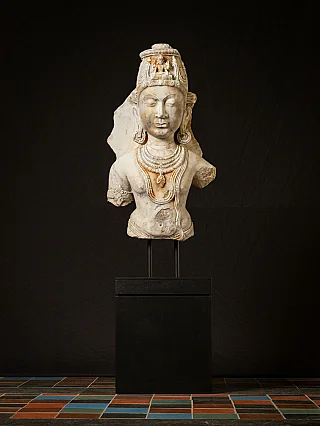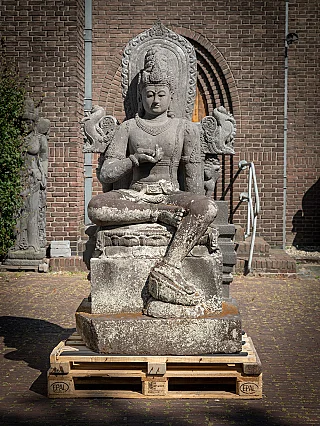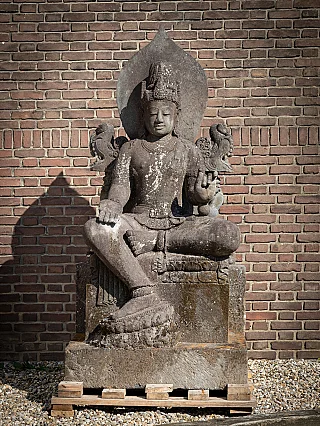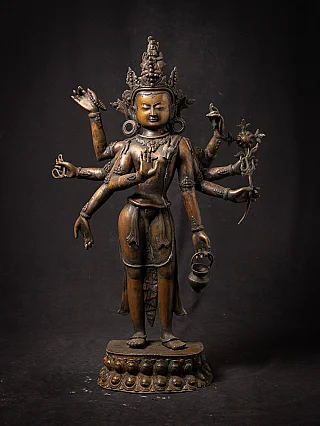Bodhisattva Samantabhadra
Author : Peter Vredeveld

Bodhisattva Samantabhadra is one of the popular and most worshipped Bodhisattva in Mahayana Buddhism. Samantabhadra is depicted riding on an elephant with six tusks or three elephants.
One of the significant Bodhisattvas, Samantabhadra, is an iconic Bodhisattva believed to be associated with Buddhist practice and meditation in Mahayana Buddhism. The term Samantabhadra means "Universal Virtue," "Universal Worthy," and "He Who is All-Pervadingly Good." Bodhisattva Samantabhadra is sometimes depicted as a bodhisattva who protects all beings who teach Dharma and is known as Fugen in Japan and P'u-Hsien in China. In the Buddhist tradition, Samantabhadra is portrayed as the one with Shakyamuni Buddha and bodhisattva Manjushri, and together they form Shakyamuni Trinity.
Samantabhadra is depicted as a Bodhisattva dressed as royalty with a lotus leaf in his hands, a "Parasol," and riding on an elephant with six tusks. The six tusks of the elephant represent six senses or sometimes six sense organs (ear, eye, nose, tongue, body, and mind). In the Nyingma School of Tibetan Buddhism, Samantabhadra is considered the primordial Buddha.
In Mahayana Buddhism
In Mahayana Buddhism, Bodhisattva Samantabhadra is sometimes portrayed alone and is believed to be the counterpart of another Bodhisattva, Manjushri. Together, they are seen in Shakyamuni Trinity. In Shakyamuni Trinity, Samantabhadra is seen on the right side of Shakyamuni Buddha carrying a Lotus leaf or sword or wish-fulfilling jewel and riding on an elephant. Sometimes, Samantabhadra is seen riding three elephants or one elephant with six tusks. These six tusks also represent the Six Perfections or Paramitas: charity, morality, patience, diligence, contemplation, and Wisdom. Bodhisattva Manjushri is depicted on the left side of Shakyamuni, and Buddha is in the center of the Shakyamuni Trinity.
Bodhisattva Samantabhadra is shown in Chinese art with feminine attributes and dresses similar to Kuan Jin. In China, Samantabhadra is worshipped, especially in Mount Emei, since it is the Bodhimanda of Samantabhadra.
In Vajrayana Buddhism
In Vajrayana or Esoteric Buddhism and most Tibetan Buddhism schools, Samantabhadra is depicted as Buddha rather than Bodhisattva. In some traditions of Tibetan Buddhism, Samantabhadra is worshipped as the primordial Buddha.
"Samantabhadra is not subject to time, place, or physical conditions limits. Samantabhadra is not a colored being with two eyes, etc. Samantabhadra is the unity of awareness and emptiness, the unity of appearances and emptiness, the nature of mind, natural clarity with unceasing compassion - that is Samantabhadra from the very beginning" – Chinese Monk Moheyan.
Appearance of Samantabhadra in Buddhist Sutra

Bodhisattva Samantabhadra appears in many chapters of various Buddhist sutras.
Lotus Sutra
Samantabhadra appears in the last chapter of Lotus Sutra, and Bodhisattva Samantabhadra is called Bodhisattva Universal Worthy and Universal Sage Bodhisattva according to different translations. Samantabhadra took great vows to protect the Lotus sutra, those who teach the Dharma, and those who follow the SutraSutra. According to the Nichiren School of Buddhism, he is depicted as the protector of the SutraSutra.
Gandavyuha Sutra
Samantabhadra Bodhisattva is the vital and iconic figure of the Gandavyuha Sutra. He appears mainly in the last chapter of the Sutra. In this SutraSutra, Samantabhadra is teaching the student Sudhana about the Wisdom that only exists for the sake of all sentient beings and must be practiced to benefit living beings.
Avatamasaka Sutra
In this SutraSutra, it is believed Buddha mentioned Samantabhadra and his ten great vows during his path to Buddhahood. The ten great vows made by Bodhisattva Samantabhadra are as follows:
- To worship and pay homage to all Buddhas
- To praise the virtues of Buddha (Tathagata) and preach them
- To give various offerings to all Buddhas generously
- To confess misdeeds and evil karma and repent for them
- To rejoice in others' merit as well as virtues and join them
- To teach and preach the Buddha teachings (Dharma) at the request of Buddha
- To request, Lord Buddha, to remain in the world
- To follow the Buddha's teachings and walk on the path at all times
- To live in harmony and help to benefit all beings
- To pass on the merits and virtues for the benefit of all beings
Share this page





















